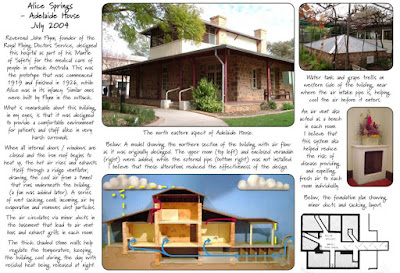Principle 11: Use edges and value the marginal
I collected a large pile of concrete which had been sitting out the front for a number of years. It had become habitat for snails mainly. Originally the concrete blocks were footpaths from around the original house, so they hadn't traveled far. This material is more commonly known as 'urbanite', and is used in some pretty
creative ways.
I've been thinking about creating a space for an outdoor kitchen for some time now, and figured that I really needed a paved area in between the shed and cellar to set it up. The urbanite seemed like the perfect answer, allowing me to clean up around the front and create a great space round the back.
My mate Dylan suggested that I make up a form and mortar mix to set the concrete block pieces onto. Seemed like a good idea to me, so after thinking about it for a few months and with summer just about to start, I decided to get stuck into it.
 |
| After clearing the space I set up a form level with the previous paving |
 |
| Using a sledge hammer I broke up the large block of concrete into more manageable sizes |
 |
| To change the block shape I found it best to sit the block on sand to distribute the weight, mark the off-cut and using a cold chisel bang out a series of dots. |
 |
| The break generally follows the line of dots, though not always. Take your time, don't try to rush it. Make sure you wear protective gear - gloves, goggles and ear muffs. |
 |
| It's like a giant jigsaw puzzle. I'd lay out a number of block to choose from and fit a bunch of them together before making up a mortar mix. |
 |
| I mixed up the mortar in fairly small lots, at ratios of six parts sand, one part lime, one part cement. Mixing it dry first and adding water gradually using a watering can to the consistency of thick whipped cream |
 |
| Starting with blocks at the edges I dragged a long straight edge I got the individual blocks level using a rubber mallet till the straight edge rested on the form work. The mortar mix that runs right to the edge of each block to prevent them tipping. |
 |
| Were the ground was quite low I topped it up with sand and compressed it with the rubber mallet leaving a good 10mm or so for the mortar mix |
 |
| The giant jigsaw puzzle complete, quite a mission. |
At this stage I still wasn't sure how I was going to fill in the gaps. Originally I was thinking that I would fill it with stone, allowing the water to run through it. If I allowed plants to grow between the gaps then I would need to water them. I thought it best to fill in the gaps and allow the water to run off to garden beds.
 |
| Gaps between the blocks were filled with rubble and a wet mortar mix was poured in until it was close to level. The wet mortar mix was 9:1:1 Sand:Lime:Cement. |
 |
| When the mortar was completed and still moist I wet it down and cleaned off excess with a wire brush and broom. |
 |
| I added mortar to the edge of the building to ensure water kept away from the timber. |
 |
| Once reasonably dry I used a pallet knife to create channels to divert water off the paved area and onto the garden, smoothed off with finger |
 |
| Using a screwdriver I scraped back some of the mortar to help define the edges - best to wear gloves for all work with cement, it's tough on skin. |
 |
| After cleaning up and defining the edges of the blocks |
 |
| The finished paving job looking to the west |
 |
| Looking east at paving for future outdoor kitchen after first rains |
UPDATE: From Dec 26th 2013
I'd been looking at the detail work that was needed for a little while and decided to give the blocks a clean up with a wire brush to get rid of the excess mortar. Best done before the outdoor kitchen job begins.
 |
| Crazy Urbanite Paving before mortar cleaned from blocks |
 |
| After mortar cleaned from blocks with a wire brush |
 |
| Crazy Urbanite Paving detail |




Comments